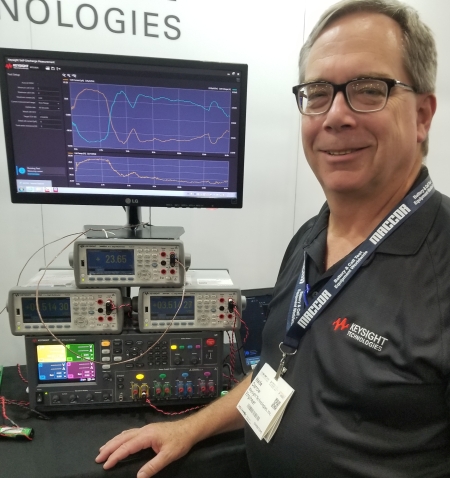How do you measure self-discharge current in lithium-ion batteries?
 All batteries self-discharge to a certain degree, and lithium-ion batteries self-discharge about 5% in the first 24 hours after charging and then lose up to about 2% monthly. As you might imagine, there is a lot of interest in exactly measuring li-ion self-discharge currents. That is what this proof-of-concept instrument stack from Keysight does, seen here next to Keysight’s Wade Darrow. The setup uses the fact that battery potential drops slightly with time even if the battery isn’t connected to a load. The instruments shown here basically keep the li-ion cell potential constant and measure the amount of current that must be supplied to do so. That current is equivalent to the battery self-discharge current. The setup, called a BT2191A self-discharge measurement system, includes a dc power analyzer which provides the feedback to tightly regulate battery voltage, and three DVMs, one of which is measuring battery temperature. A multichannel version of the instrumentation is called the BT2152A.
All batteries self-discharge to a certain degree, and lithium-ion batteries self-discharge about 5% in the first 24 hours after charging and then lose up to about 2% monthly. As you might imagine, there is a lot of interest in exactly measuring li-ion self-discharge currents. That is what this proof-of-concept instrument stack from Keysight does, seen here next to Keysight’s Wade Darrow. The setup uses the fact that battery potential drops slightly with time even if the battery isn’t connected to a load. The instruments shown here basically keep the li-ion cell potential constant and measure the amount of current that must be supplied to do so. That current is equivalent to the battery self-discharge current. The setup, called a BT2191A self-discharge measurement system, includes a dc power analyzer which provides the feedback to tightly regulate battery voltage, and three DVMs, one of which is measuring battery temperature. A multichannel version of the instrumentation is called the BT2152A.


Thank you for sharing the latest announcements from Rohm’s EV Power Seminar.